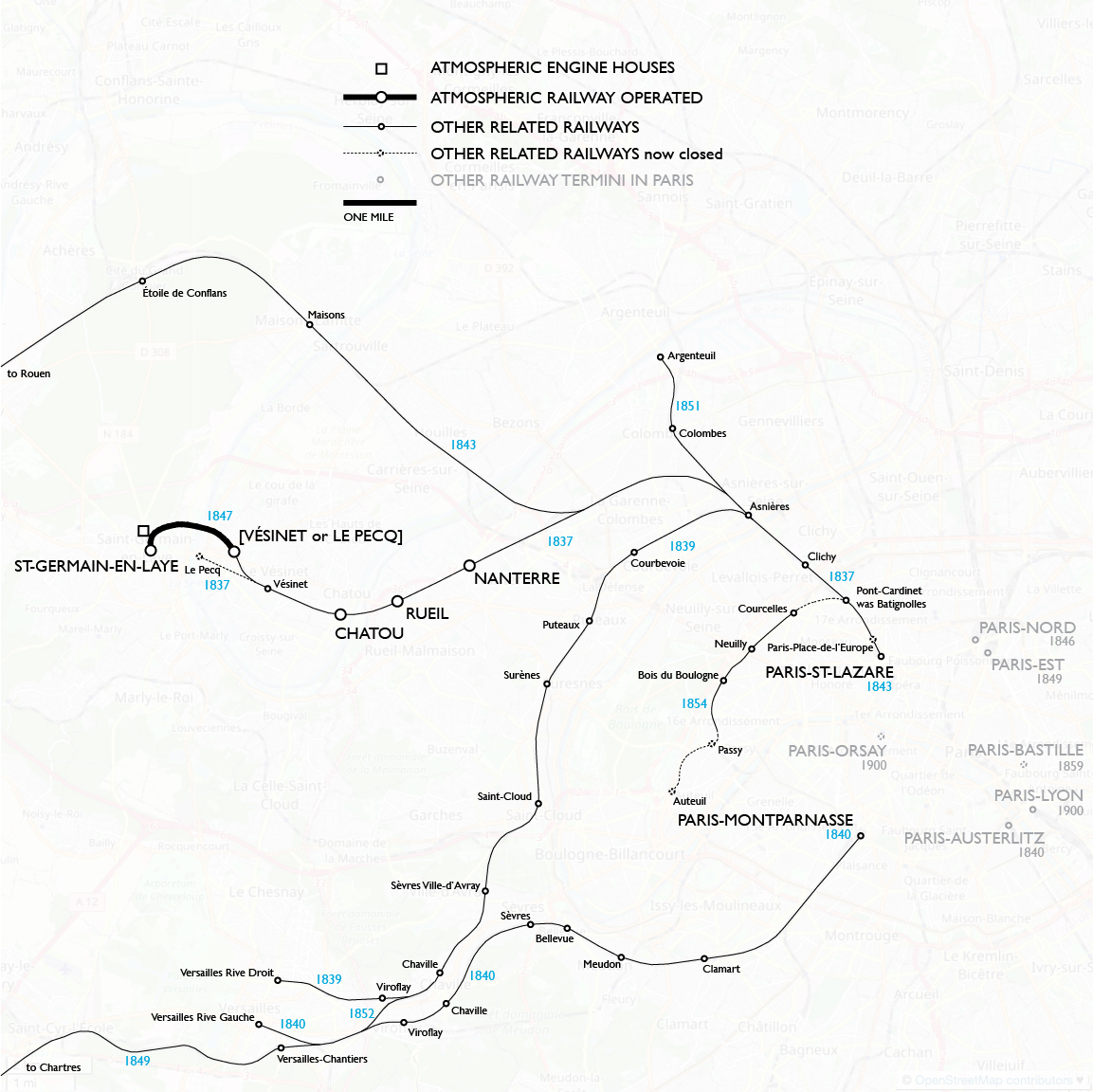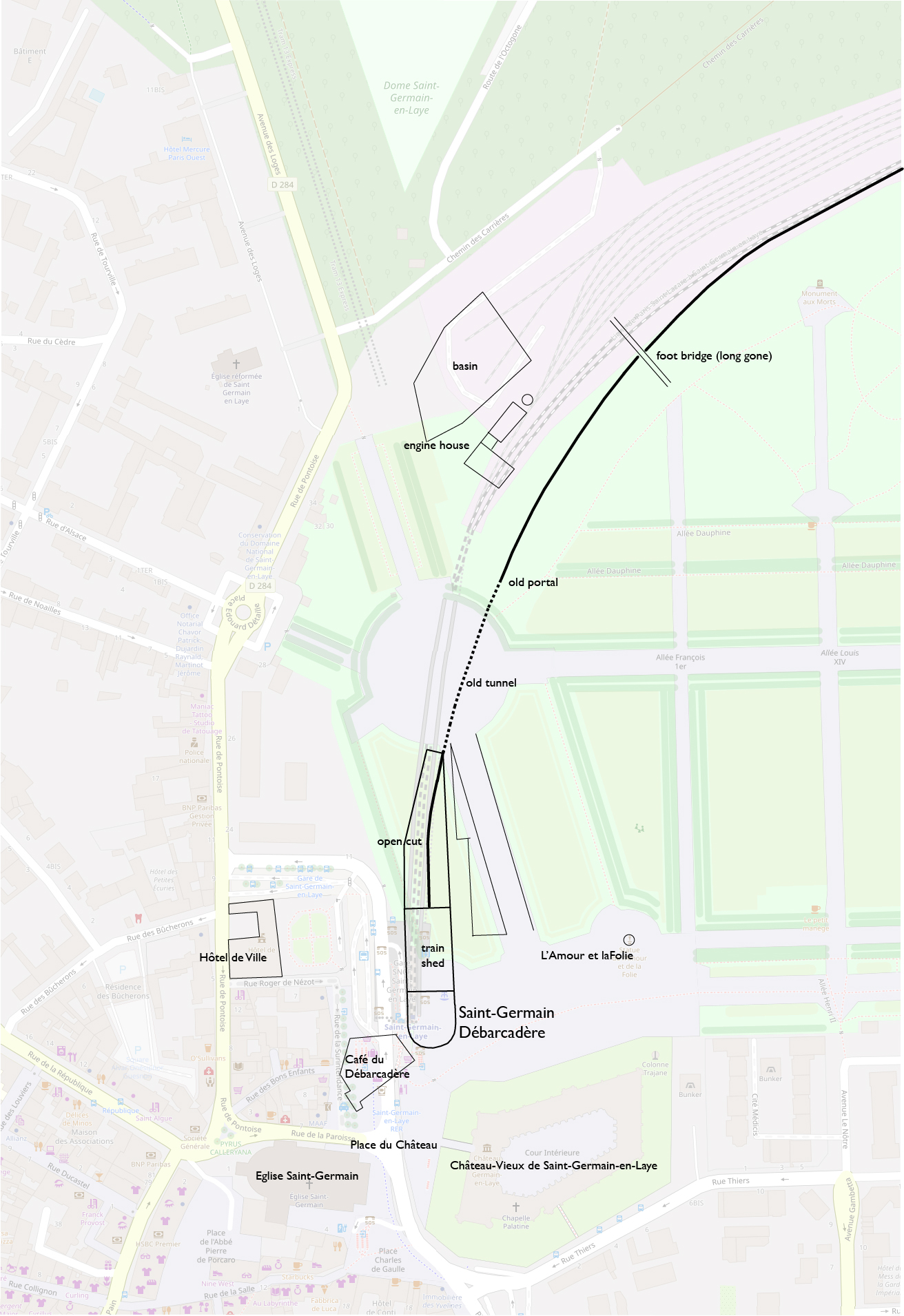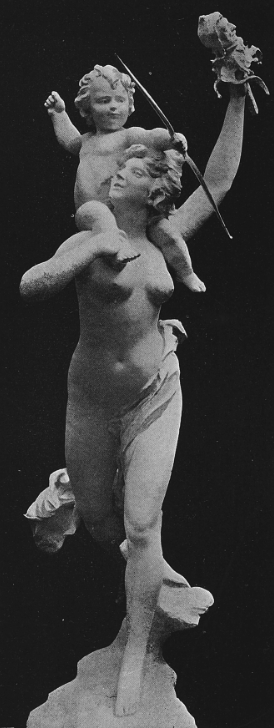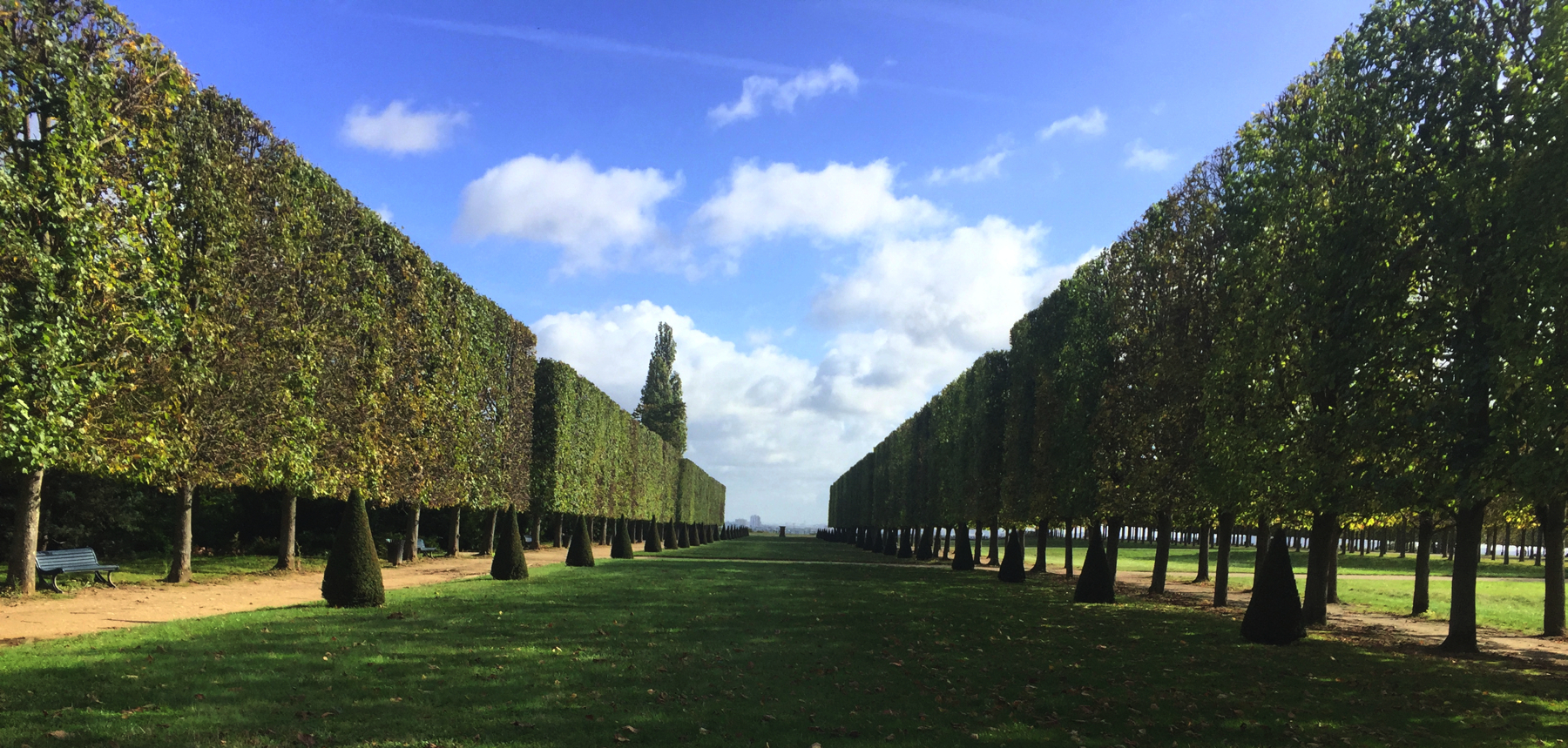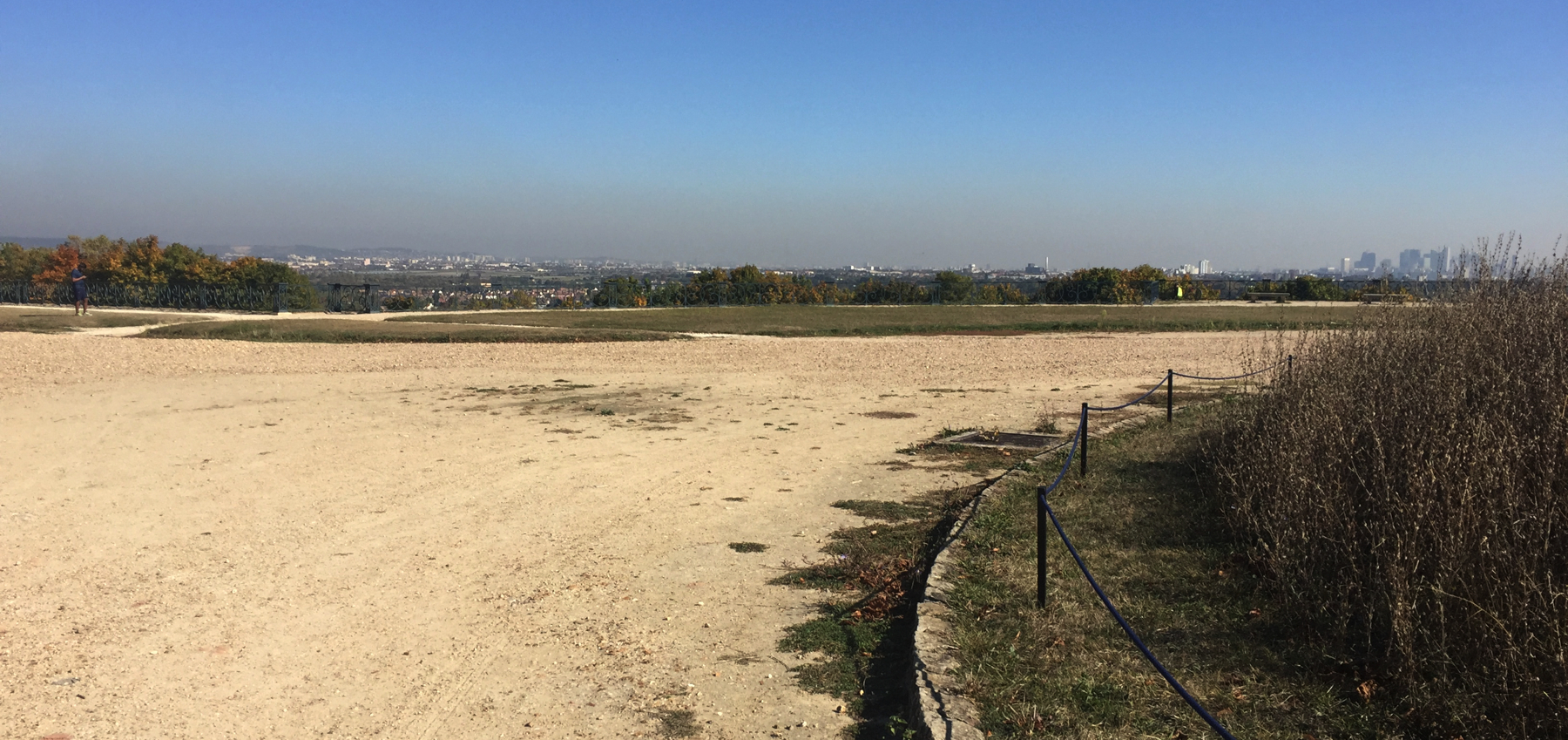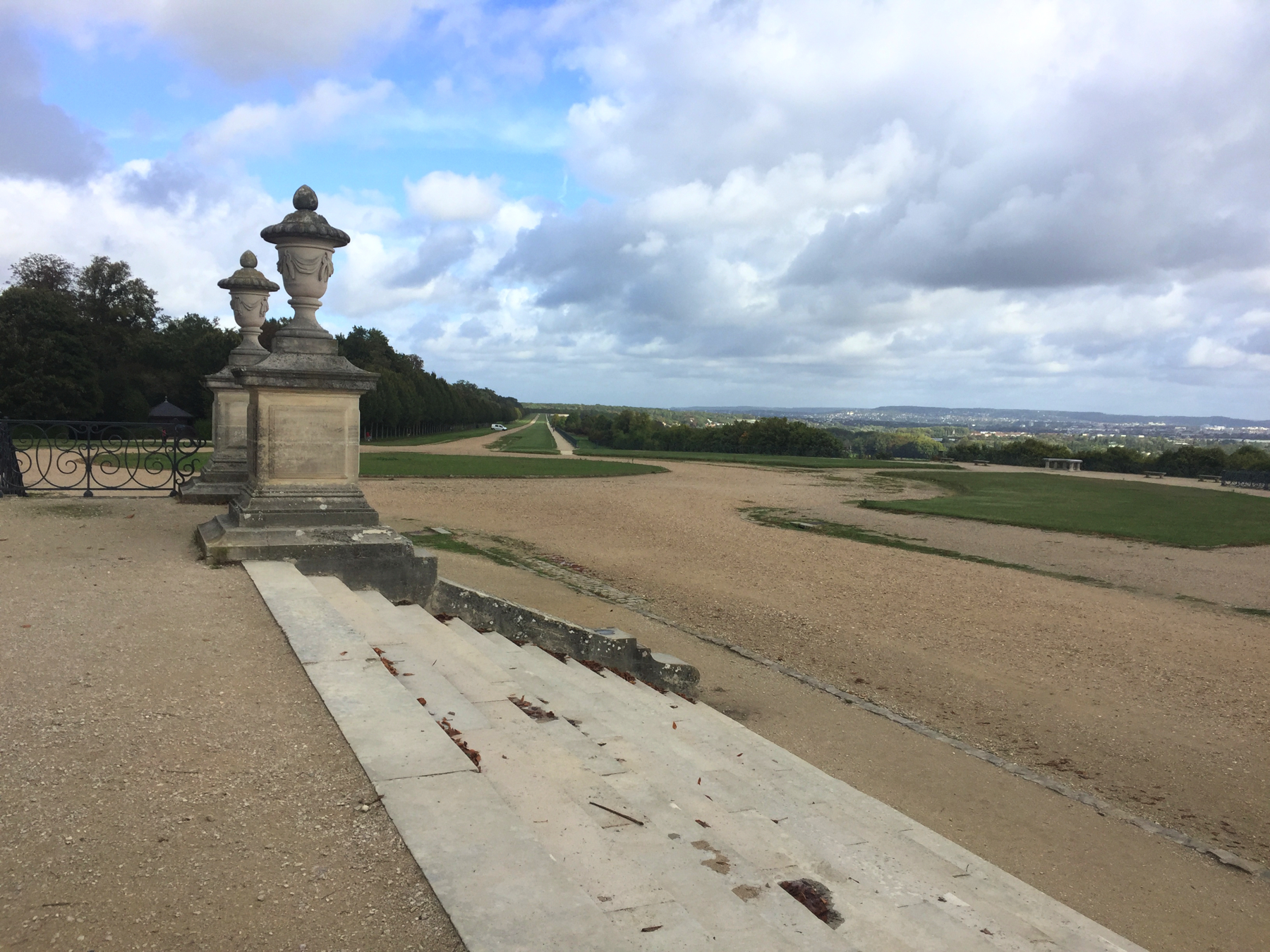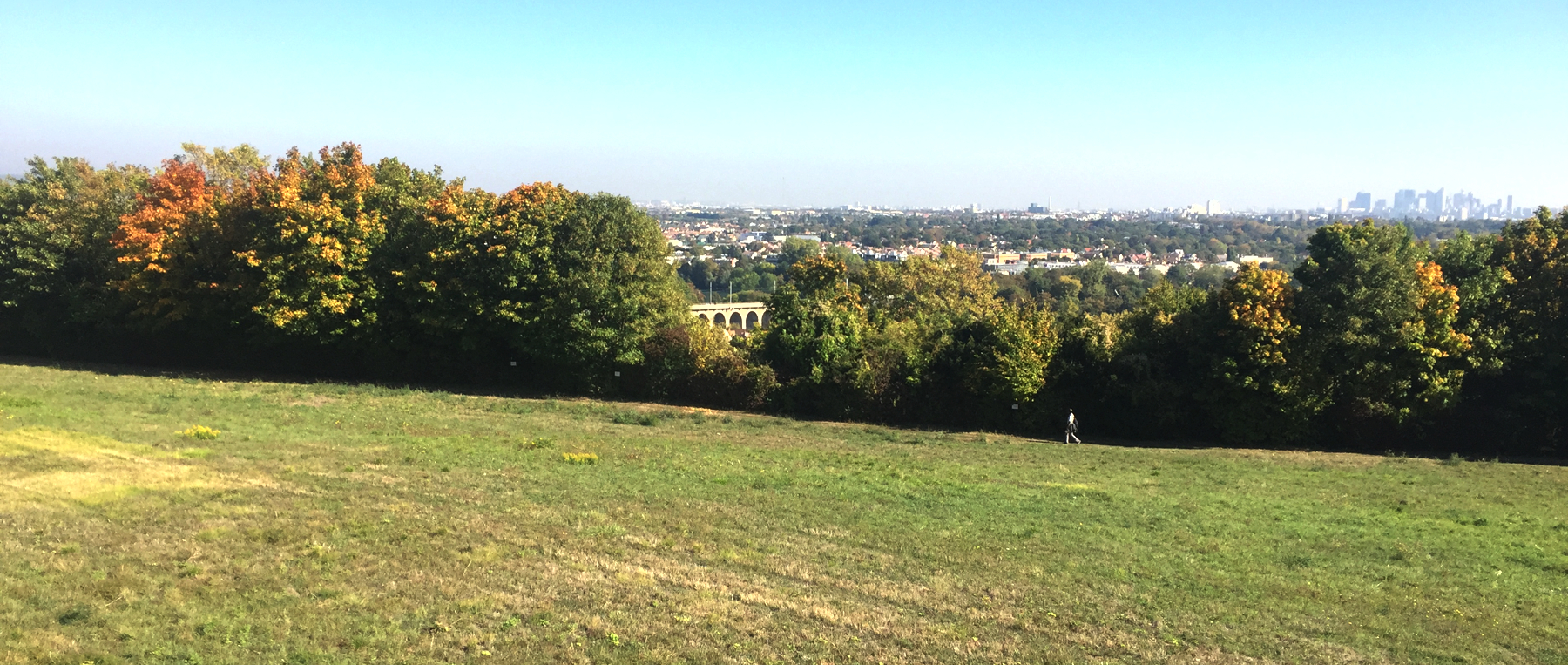Chemin de fer de Paris à Saint-Germain
Saint-Germain-en-Laye
In which Joe goes deeper into the foreign land to see many things that are no longer there, and finds himself considering love and folly and what the Laye is that Saint-Germain is in.
Explorations: Wednesday, 10 October 2018, and Thursday, 10 October 2019.
Journey: Châtelet-Les Halles to Saint-Germain-en-Laye, RER A.
-
OFTEN CITED REFERENCES
- Paul Smith, "Chemins de fer atmosphériques", in In Situ,
no. 10 (2009), online:
première partie, and deuxième partie.
The most important part of the Saint-Germain atmospheric railway was the last stop, the Débarcadère at the place in the company's title, Saint-Germain-en-Laye. In the previous page on Le Pecq we saw how the railway rose up and crossed over the Seine and continued up over the flood plain on a high viaduct.
It did not need to reach ground level in Saint-Germain. Out of respect for the formal gardens and the old Château, or that is to say, to meet requirements set by the town, the railway runs in two tunnels and two open cuts to reach a subsurface station. The first tunnel starts within the limits of Le Pecq, the commune boundary having been set at the outer edge of the Terrasse, just a little bit farther west than the portal. The day when I was admiring the viaduct I chose not to add another mile to my walk by going up the Allée des Gas to see the entrance myself, so instead I use the image below of an RER train going in.
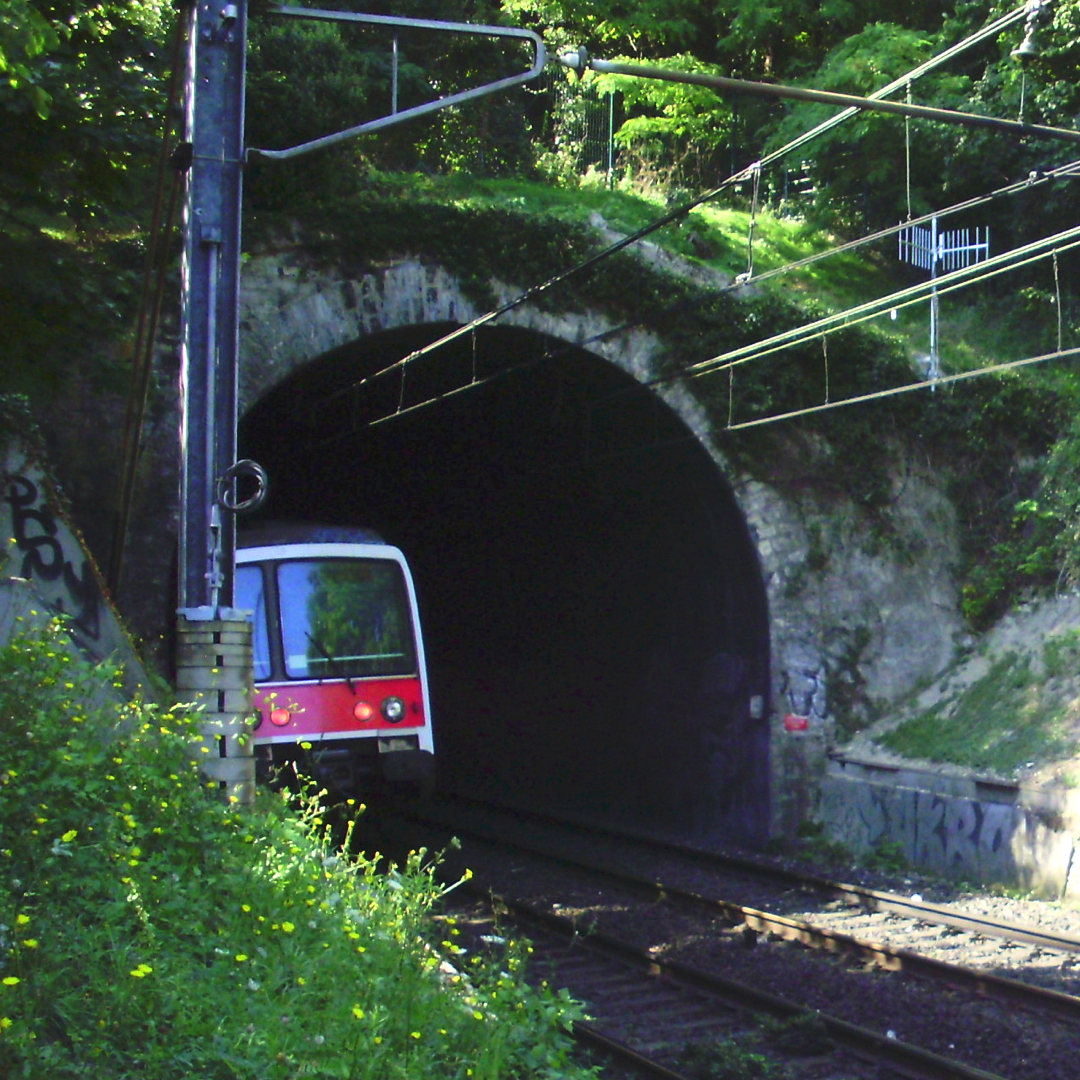
— Geralix, "Entrée est du tunnel de Saint-Germain-en-Laye, sur la commune du Pecq...", 3 September 2010. link. Wikipedia Commons, CC BY-SA 3.0.
Statement of modification: cropped to emphasize the tunnel.
The gigantic illustration I provided on the Le Pecq page shows the rounded tunnel entrance under a pointed stone arch. The point might be there under the greenery.
Saint-Germain-en-Laye is situated on a plateau described in 1838 as plus belle vue qui existe en Europe et dans l'univers même, si on calcule les souvenirs historique qu'elle déploie (Adolphe Breant, Notice historique, statistique et biographique sur St-Germain-en-Laye). King Louis VI built a castle here in 1124, which was later enlarged. All but the chapel was destroyed during the Hundred Years' War by the Black Prince, son of the English king Edward III. The present Château dates from 1539 with later additions. The geometric formal gardens were established by 1673, including the long Terrasse with its view extending to Paris. When the atmosphérique opened Saint-Germain was already a travel destination. Since then the old Château has seen good times and bad, but it is now home to the Musée d'Archéologie Nationale, and it, the gardens, the terrace, the forest to the north, and upscale hotels and restaurants have made Saint-Germain even more popular with tourists.
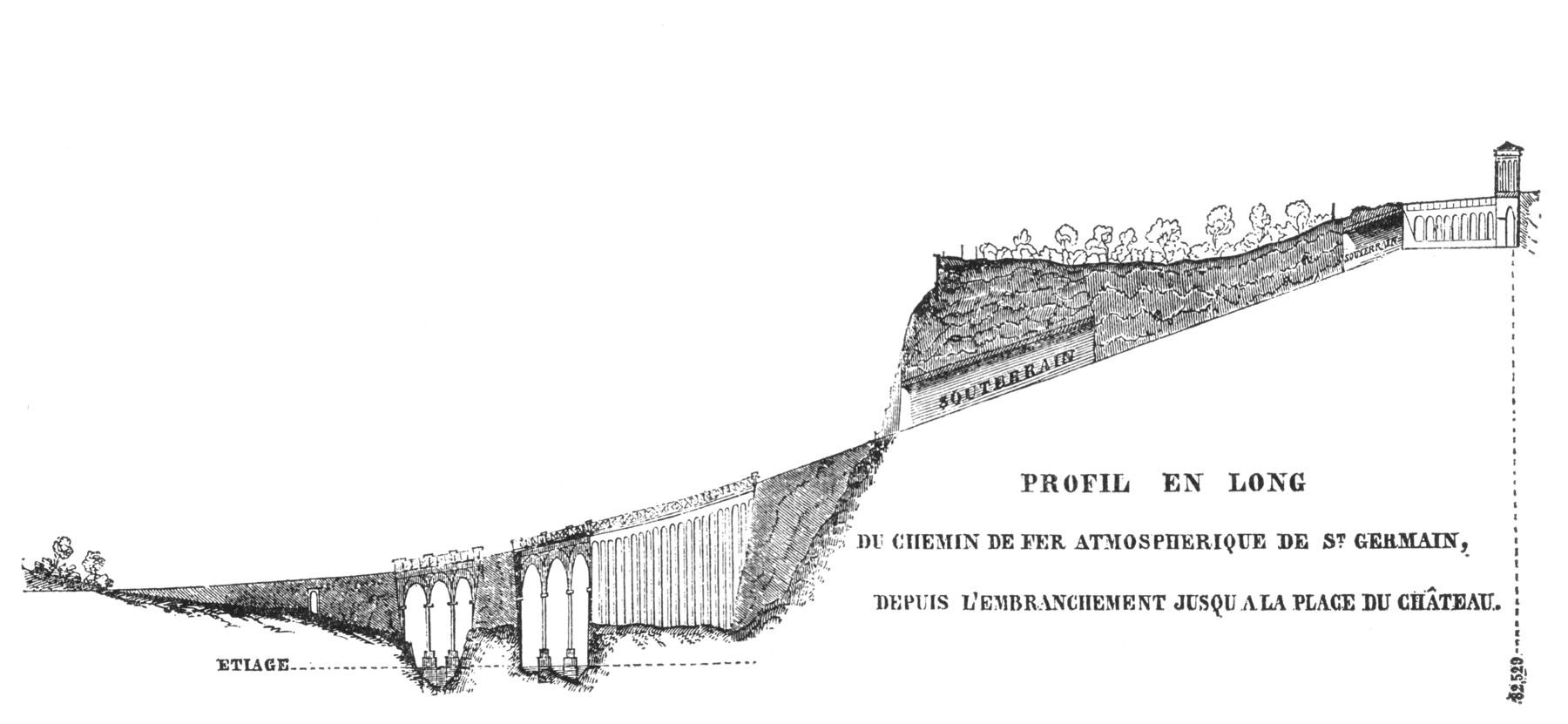
— Profil en long du chemin de fer atmosphérique de Saint-Germain depuis l'embranchment jusqu'à la place du château, 1845.
The profile above looks south, from Le Pecq on the left, and shows in the customary exaggerated vertical scale the grade of the railway up to the terminal. The slope is shown as gradually increasing over the whole distance, which is not quite right. Company engineer Eugène Flachat correctly predicted that the vacuum would become stronger as trains approached the engine house, and therefore he allowed the 2½ per cent grade to increase to a bold 3½ per cent toward the upper end of the viaduct. After the tunnel the railway is in open cut, out of view of visitors walking in the forest, until, past the the huge atmospheric engine house, it entered a short tunnel to reach the open cut at the station, running slightly down hill to the end of track. (Today it enters a different tunnel and remains underground at the RER station.)
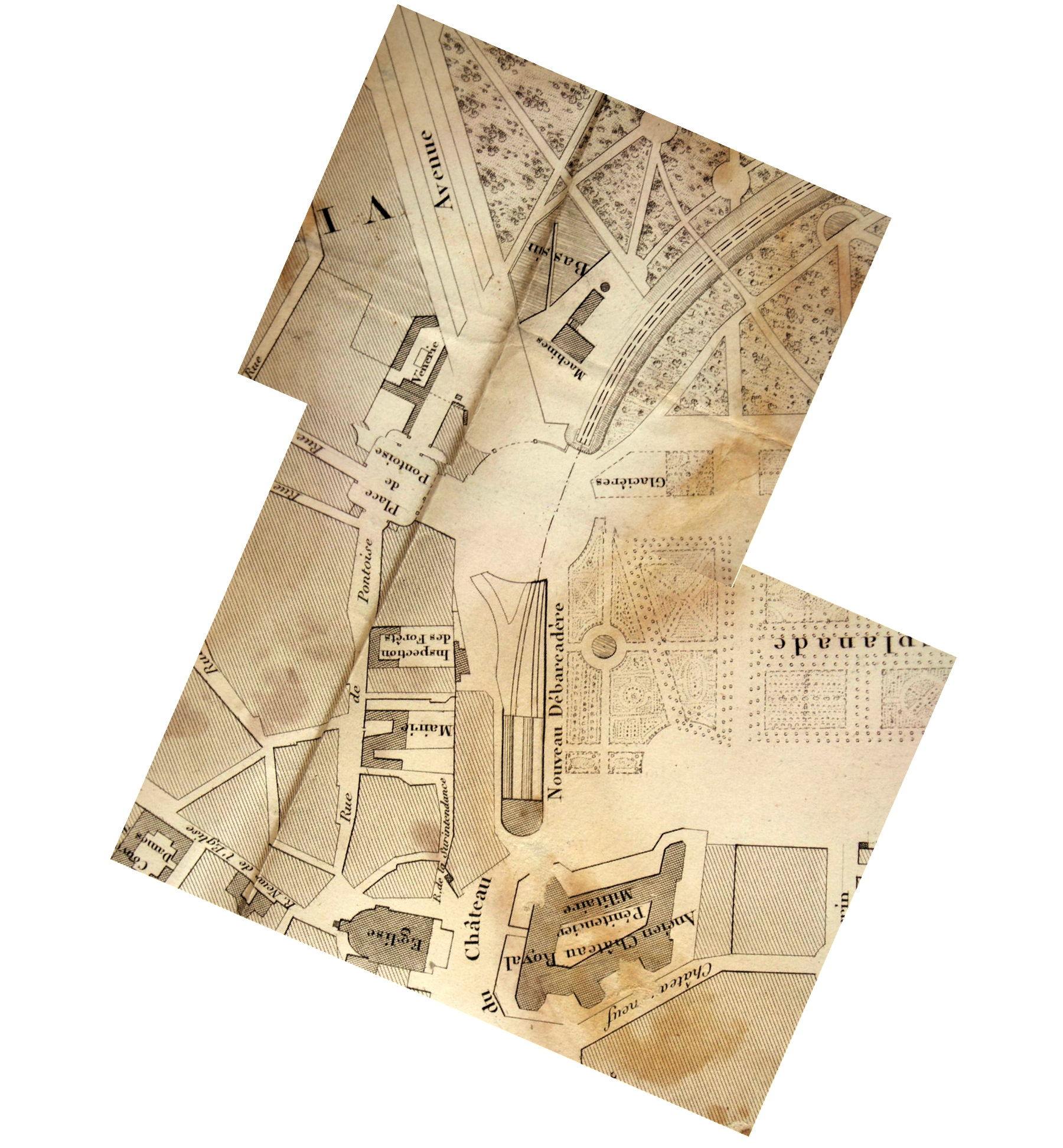
— Adolphe Masson, Emplacement du nouveau débarcadère à Saint-Germain, en face de l'ancien château royal, 1845, composite of two images, via Paul Smith.
I was very pleased with the plan above, because I thought it was a carefully surveyed engineering drawing, until I tried to overlay it on modern maps and realized it is not. Nonetheless it shows approximately what was built during the next two years. From the top, the two tracks curve through the open cut, passing under a footbridge, and then past the machines, continuing up under a rond point, which, according to earlier drawings, was not there until the railway was built. The tracks still curved as they entered the open cut, finally running straight within the station.
For lack of any reliable large-scale map, I drew the plan below based partly on the drawing above and partly on photographs, some of which will appear below. A significant difference from the 1845 drawing is that a photograph shows the that the eastern side of the station house and open cut line up to the middle of the rond point. My plan is probably not quite right, but it's the best I can do.
The RER station is longer and deeper than the old station. The old station floor was about 20 feet below street level, more than needed for atmospheric trains but a reasonable allowance for steam locomotives. At about that floor level the RER station has a generous mezzanine for ticket sales, small shops, and fare gates, with the platforms and tracks another level deeper. The RER trains needed longer platforms than the old station, and since a subsurface extension closer to the château must have been ruled out, the solution was to curve farther out on the approach with a new tunnel under the rond point.
Below is the only known illustration of the Saint-Germain atmospheric railway in operation. The footbridge offered a remarkably good view of the proceedings. We learn from this view that the pipe was laid on the south side track, and that there were already sidings near the top at the time the railway opened, three days before the publication date of this number of the popular paper L'Illustration. The positions of the chimney, the boiler house, and the very large engine room are consistent with the 1845 drawing I showed above.
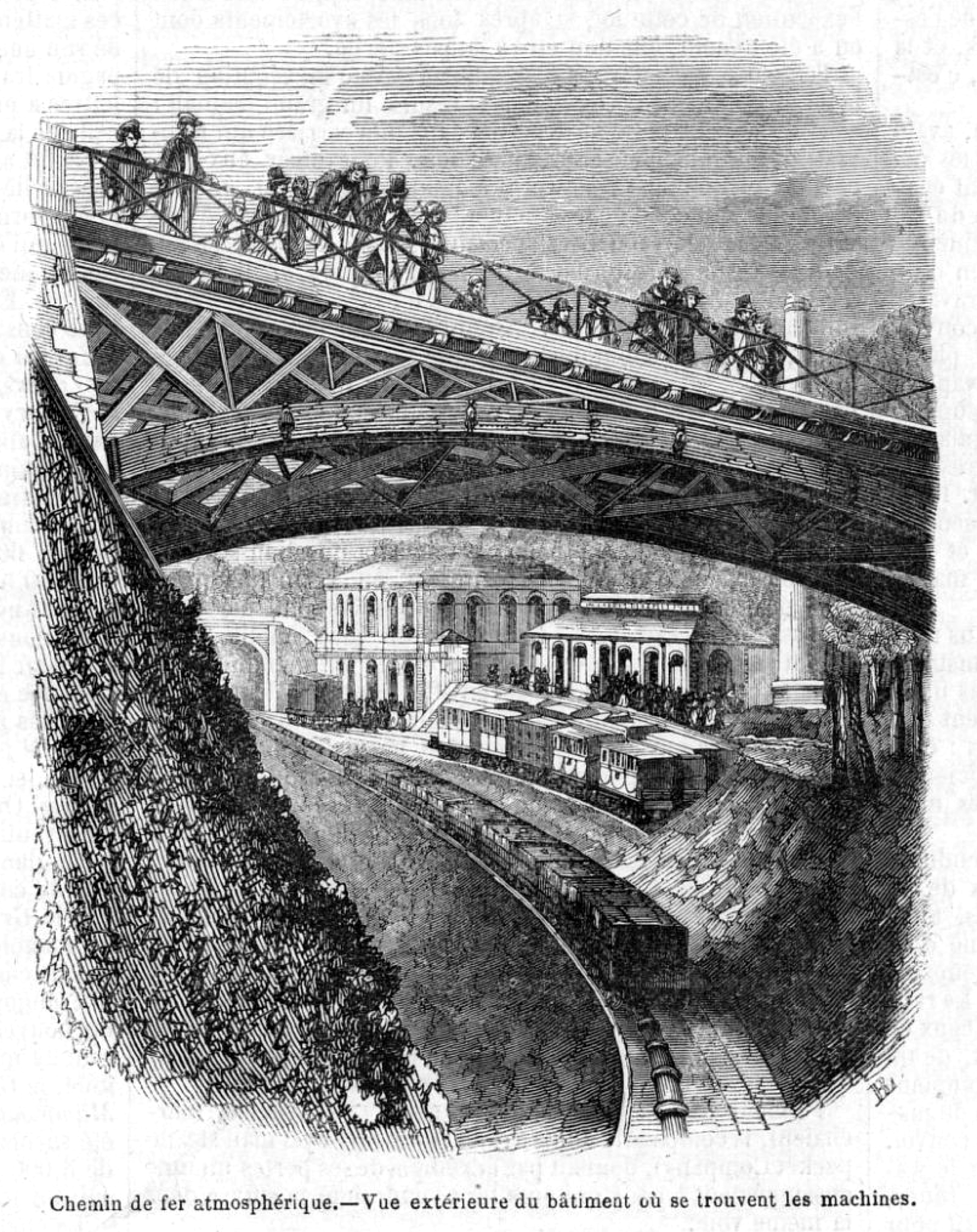
— "Vue extérieure du bâtiment où se trouvent les machines." L'Illustration, 17 April 1847.
The great popular interest in Saint-Germain led to a large number of postcard views being sold. Some strayed from the usual points of interest to show the railway facilities. They are later than the atmospheric period but they do show structures remaining from that time.
The card below shows a locomotive laboring up the 3½ per cent grade on the former atmospheric track. The boiler house seems to be abandoned and surrounded by overgrowth, and the chimney is gone, but the large building for the engines seems to be intact, and the sidings are in the same location. This postage stamp was introduced in 1903, and the date of the photograph is probably not much older. I wonder what was still in the engine house forty years after it was obsolete.
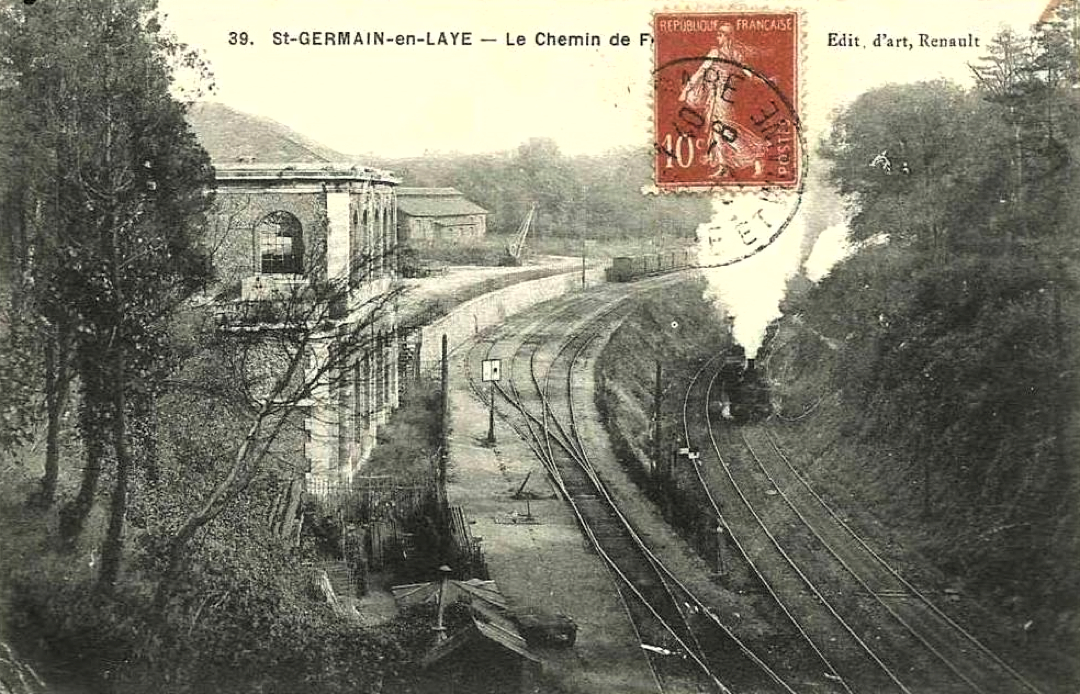
— Postcard. "St-Germain-en-Laye — Le Chemin de Fer."
In a colder season (see the trees) a photographer stood in the same place and captured a view of a train that may have been squealing its brakes on the way down. Now the sidings are more full. Despite the blur of this copy, I am including it partly because it shows quite a cant on the curve. In the back is the same crane next to the boiler house, its purpose unknown to me. The three-way switch, something normally avoided, suggests how tight space was.
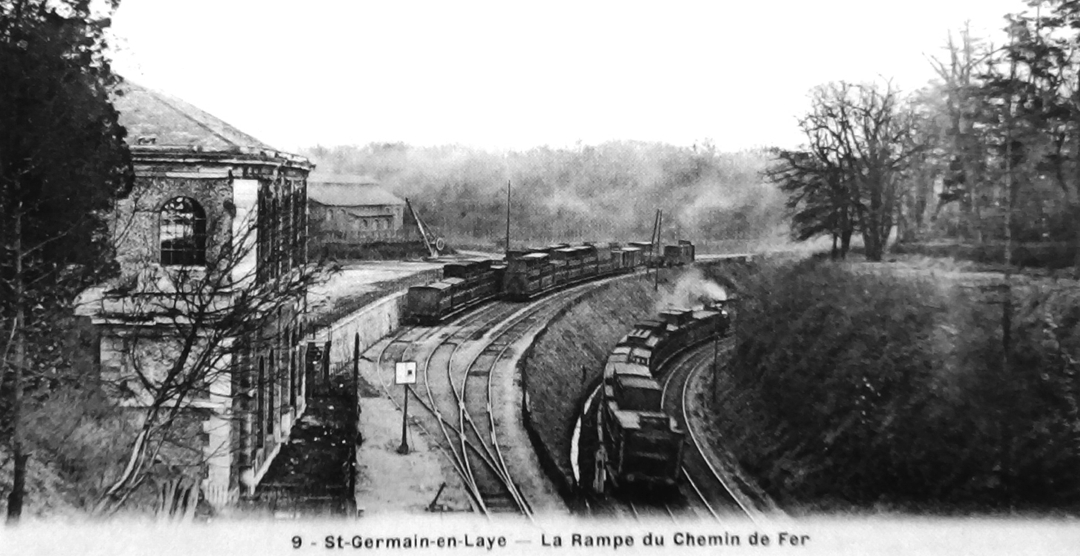
— Postcard (detail). "St-Germain-en-Laye — La Rampe du Chemin de Fer."
I was not able to stand in the same location, or at least not without trespassing on staff-only grounds, but below I can show at least a similar view. In 2018 I found a spot between trees on the north side of the rond point where I could get a look. I'm farther to the right and a little bit farther away. A century and a half later, this location is still the choice spot for sidings. As near as I could determine the RER tracks, making a wider curve, encroach on the site of the engine house, and they are below the level of the original line. The net result is that the RER has an easier curve and an easier grade.
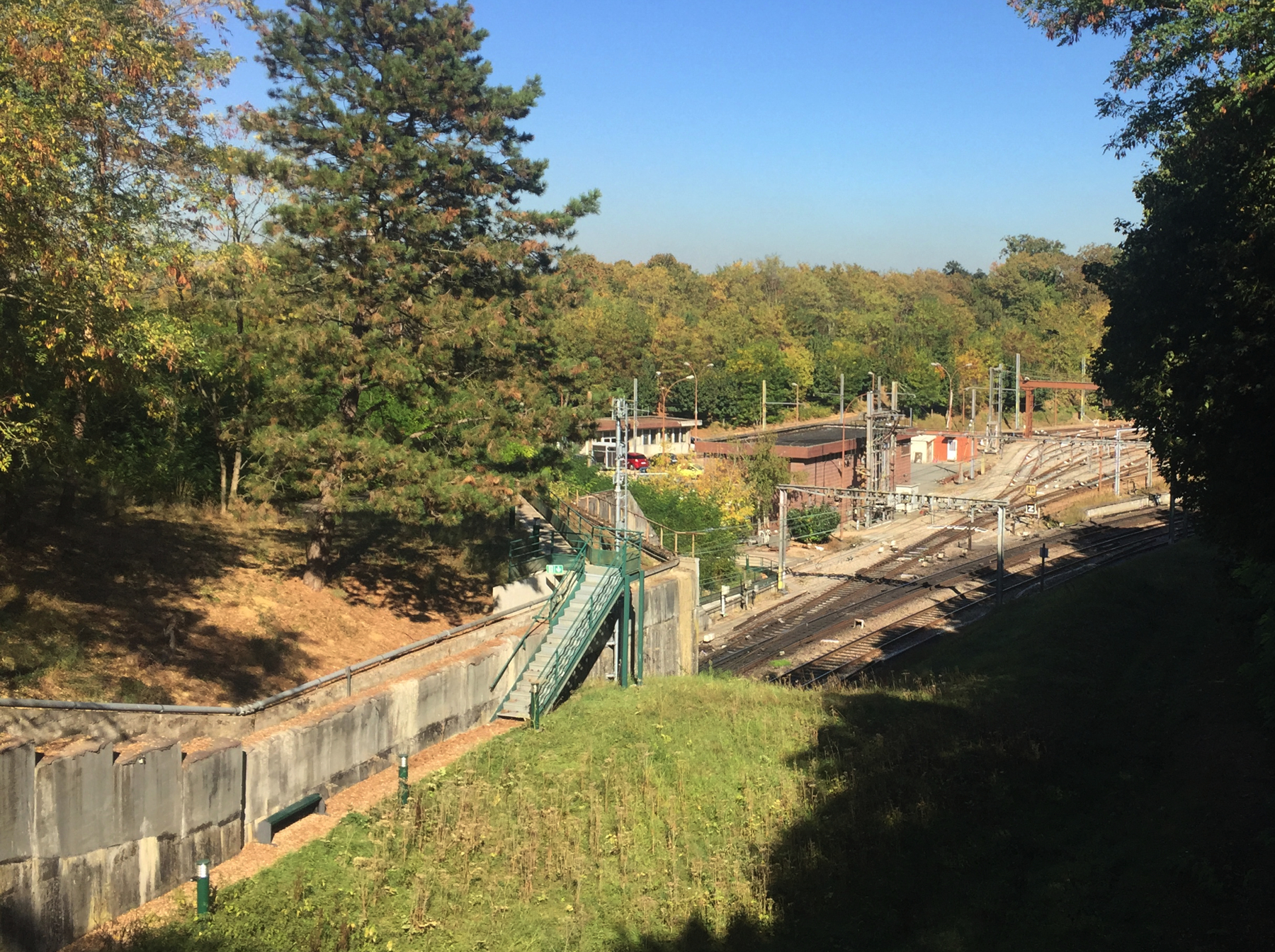
In my photograph above, the RER tunnel entrance is at the concrete walls in the center of the image. Staff on break can walk over the portal and down the steps to the grassy area in front of the old tunnel, where there is a picnic table they can use! The old grade was lower than the lawn in the foreground, where the ground level was raised next to the modern tunnel portal. The old tunnel entrance was right below my feet.
Below, in 2019 I was able to grab a shot from the train window showing both tunnel entrances, almost the reverse view of the one above. The old stone base wall on the left, the edge of the old railway alignment, seems to end, but it is actually covered by fill that raises the ground level approaching the arch. Ground was raised even more next to the RER portal, creating the lump of grass seen in the previous photo. The steps in that photo are immediately to the left of the RER portal but hidden from view here by that trackside thing.
I wonder what is behind the very nicely glazed archway.
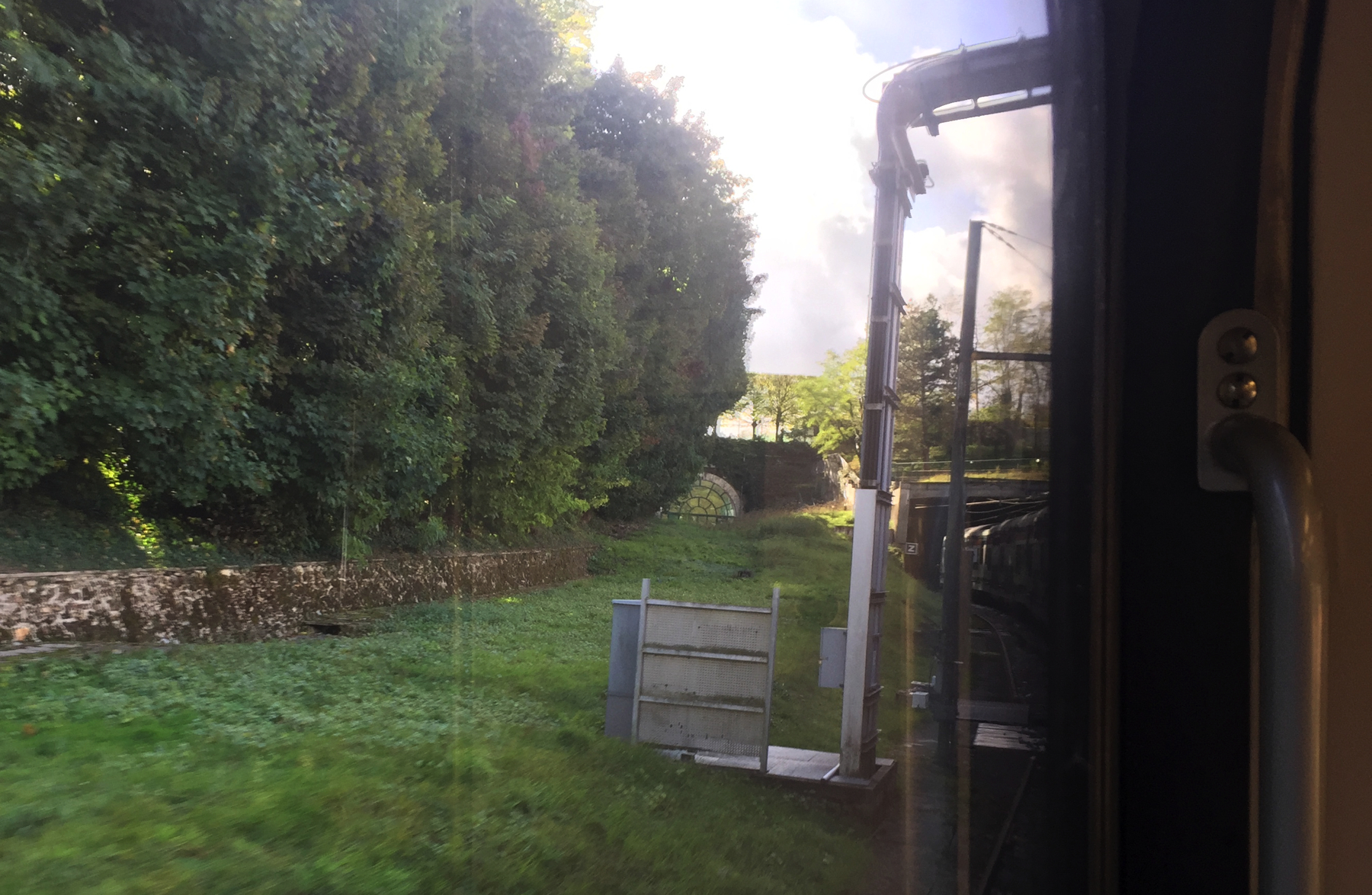
THE STATION AT SAINT-GERMAIN
Now let's look at the station house for the atmospheric, a wonderful design by the company's architect Alfred Armand, who was also responsible for the riverside terminus at Le Pecq and the first version of Paris-St-Lazare. None of them are still standing. Flachat told public officials in August 1845, "Il n'existe certainement pas en France une gare de chemin de fer située dans des conditions aussi advantageuses et dans aussi magnifique exposition."
The station front at the Place du Château was semicircular in form, consisting of nine arched openings flanked by classical pilasters. The central arch with the main door was distinguished by more rounded pilasters, a large clock above the door, and a pediment with the words CHEMIN DE FER. Inside were the usual amenities and steps down to the tracks about 20 feet below. The roof is iron and glass. I cannot explain why there are so many vents in the roof.
Immediately southwest of the station, and slightly blocking its front, stood the Café–Restaurant du Débarcadère. It's visible in every photograph of the station.
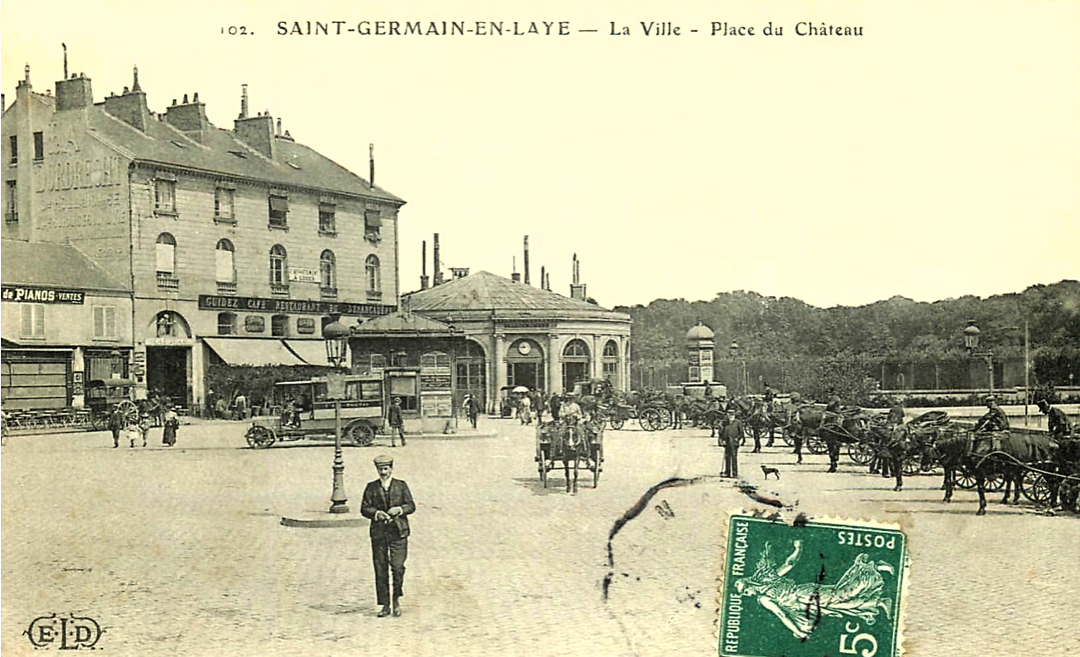
— Postcard. "Saint-Germain-en-Laye — La Ville — Place du Château."
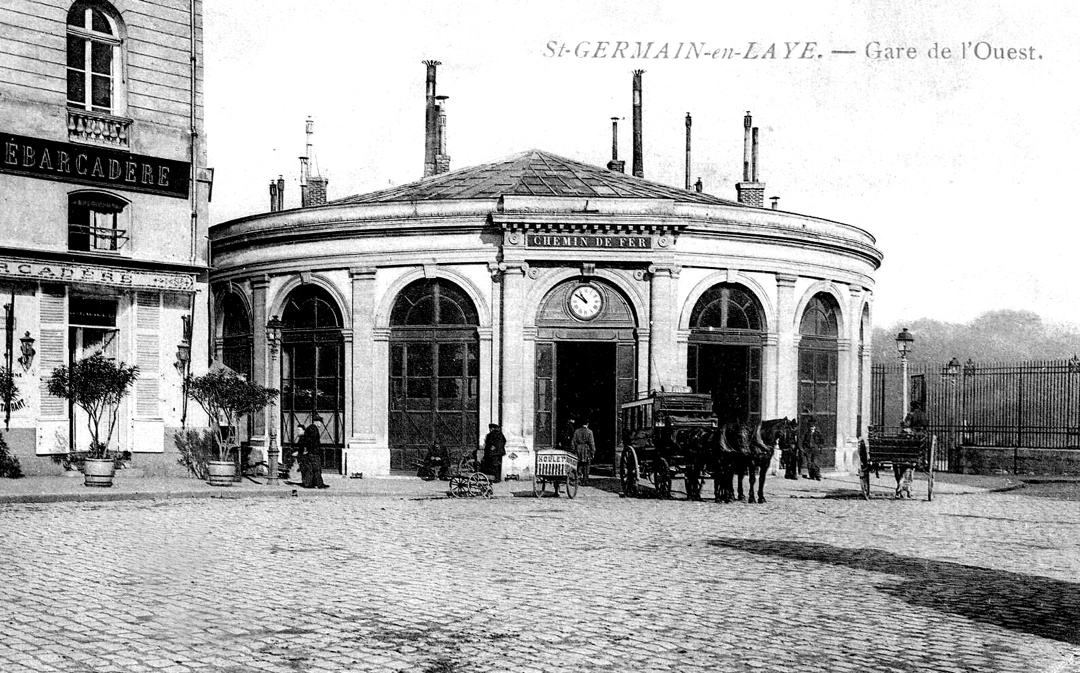
— Postcard. "St-Germain-en-Laye — Gare de l'Ouest."
In both views above we are looking north, with the Château just out of frame to the right. In the second card it is casting quite a long shadow for ten of eleven in the morning. What was left of the Parterre is fenced off in the right background.
Below, we have gone up into the Château to a high window or possibly the roof. Now we can see the open cut for the railway, which took part of the Parterre grounds, the rest of which is on the right. The caption calls it the English Garden, but it doesn't look like English gardens I've seen.
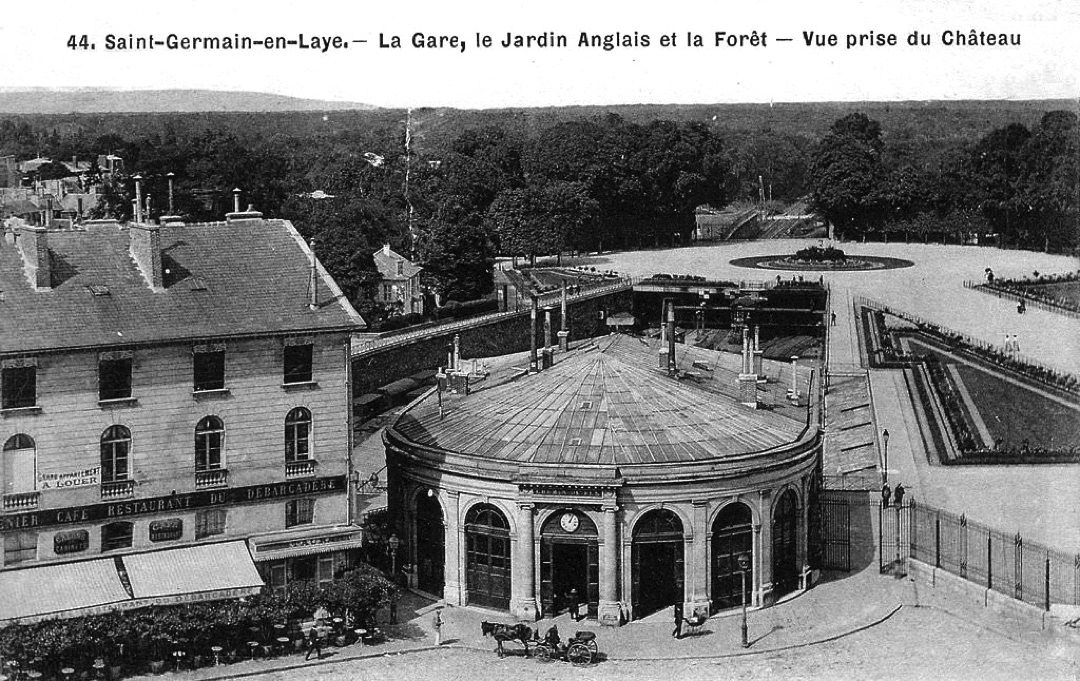
— Postcard. "Saint-Germain-en-Laye — La Gare, le Jardin Anglais et la Forêt — Vue prise du Château."
I need to mention here that in 1882 a second railway line came into the station from the Ligne de Grand Ceinture. In the view above the old Saint-Germain railway curves off to the right to pass under the rond point, and the newer line runs out almost straight north into the forest. Within the forest the now-gone route took two left turns to come back running south past the west end of town with a stop at St-Germain-en-Laye Grand-Ceinture. Trains ran this way to Paris St-Lazare on a roundabout alternate route that one guidebook considered more scenic, via Marly-le-Roi, St-Cloud, and Puteaux. As I write this RATP has been building a similar but different route in the forest to the Grand-Ceinture for a tram line.
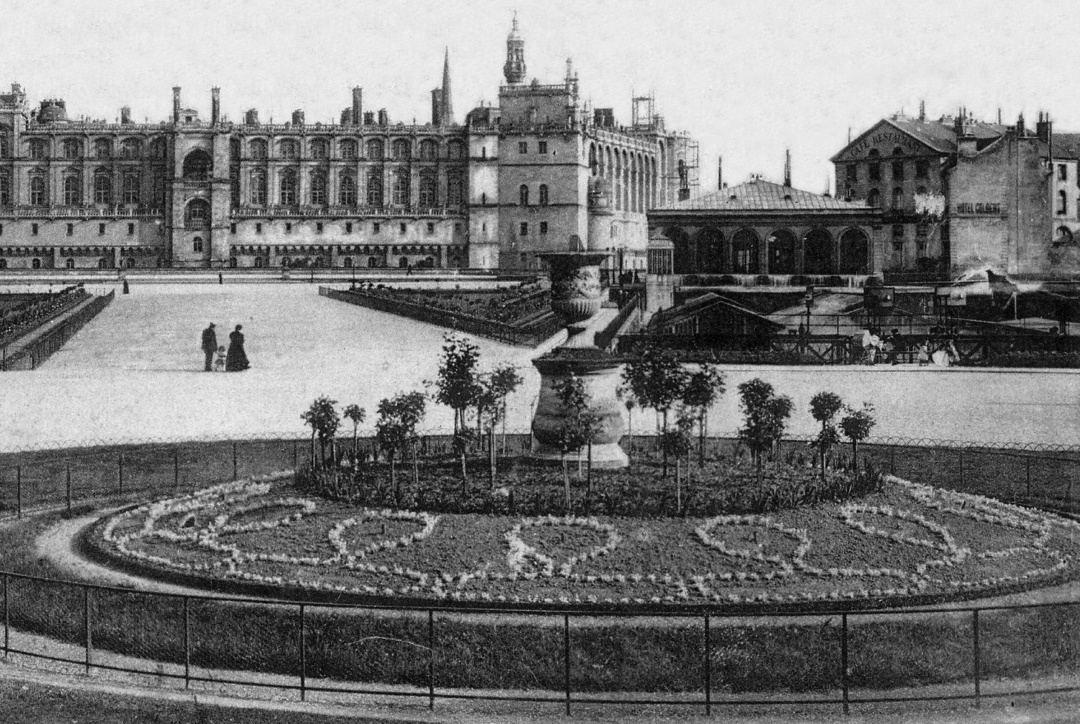
— Postcard (detail). "Saint-Germain-en-Laye — Le Château pris du Rond-Point de la Terrasse." (The view is not from the Terrasse.)
Above is the reverse view from the rond point, showing the back of the station and a glimpse of the two peaked roofs of the original trainshed. Below is my photograph of almost the same view in 2019, showing the restored garden and on the right the absence of the station and the Débarcadère cafe.
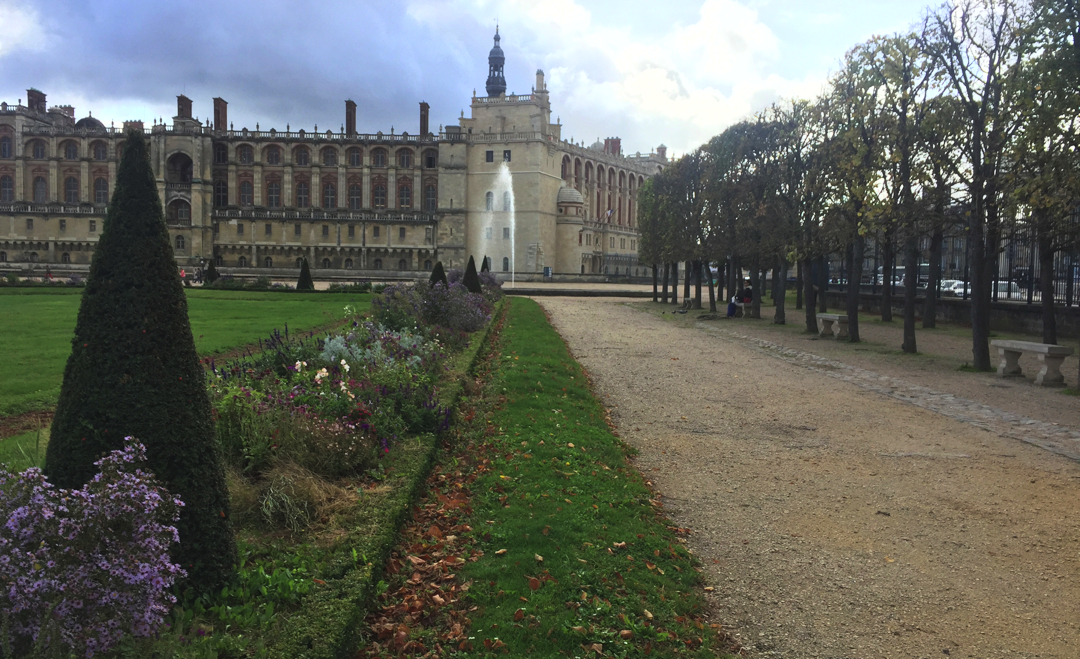
The views below show the relative positions of the Château, the church of Saint-Germain, and the station. With the station and restaurant gone, we get a better view of the church and its bell tower. The statue in the foreground of "L'Amour et la Folie" has been there since 1899. It is so French to celebrate love and folly. I like it.
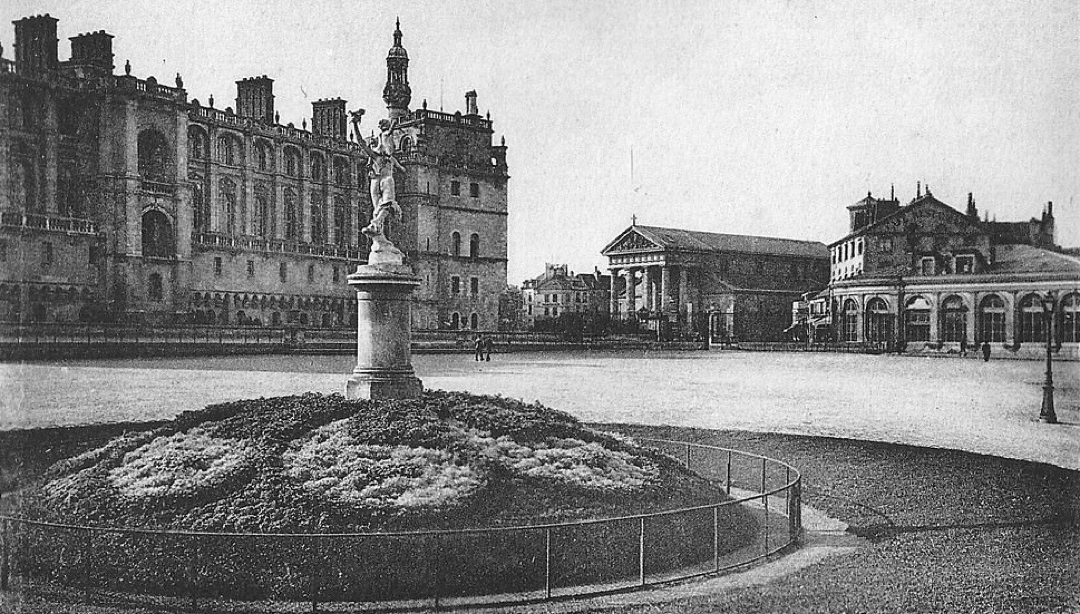
— Postcard. "Saint-Germain-en-Laye. L'Eglise et la Château."
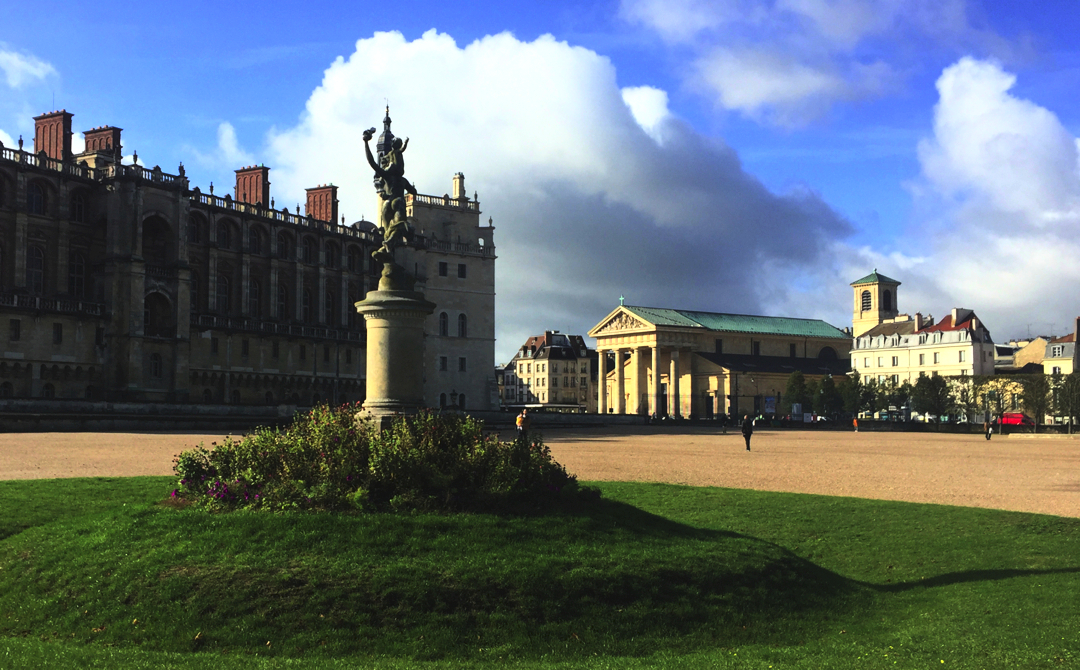
All photographs of the trainshed and platforms show the enlarged station after 1882, but it is not hard to identify the older part with the two peaked roofs. The trains include double-deck coaches. The upper "imperial" deck looks pretty scary. You go up a steep stairway, and find your way along a narrow floor between the benches and a pipe railing about a foot high. What could go wrong? The Chemins de fer de l'Ouest had them in service for years and people seemed to like them. I want to cross the Le Pecq viaduct riding up there.
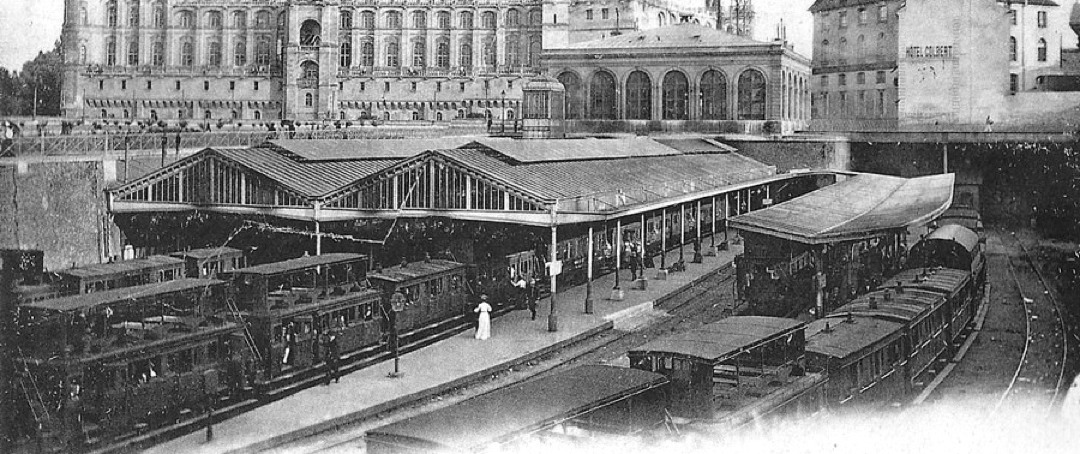
— Postcard (detail). "St_Germain-en-Laye — La Gare vue de la Terrasse." (Again, the view is not from the Terrasse.)
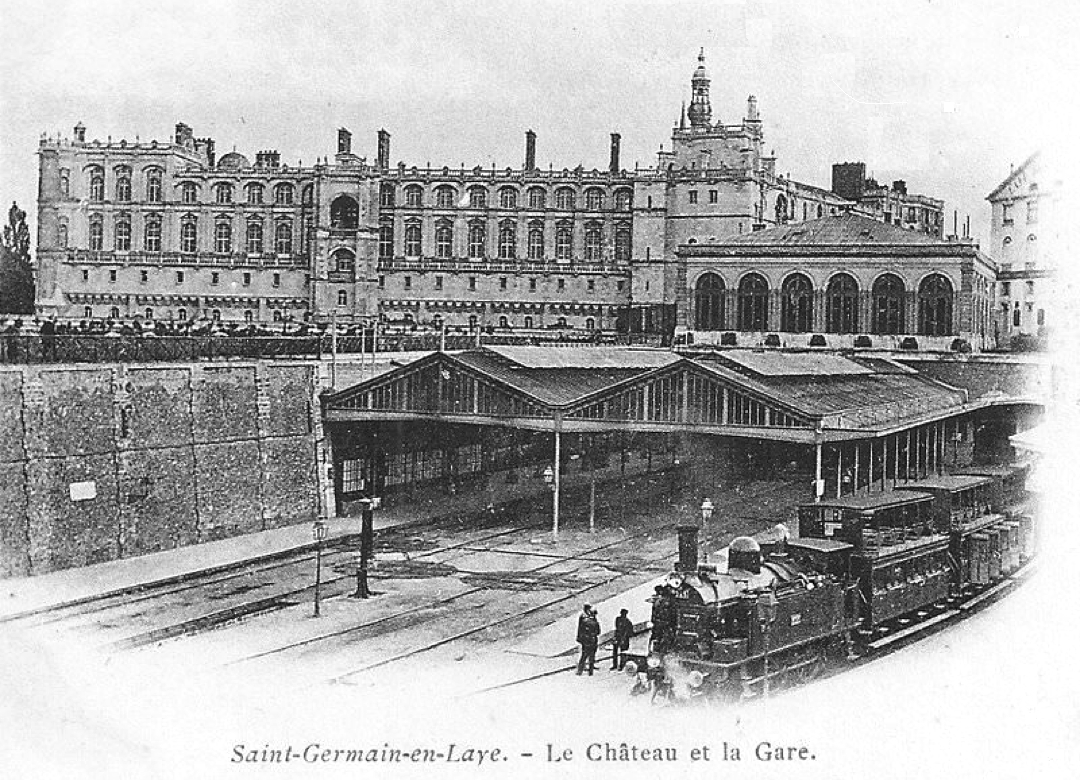
— Postcard. "Saint Germain-en-Laye — Le Château et la Gare."
The postcard just above shows four turntables on the tracks of the old station. They were large enough to turn engines like the one shown. My guess is that trains came and went on the outer two tracks, with the center pair as escapes for the locomotives, and earlier for the piston carriages.
Below is the station in 2018. I wish they could have taken apart the old station house and put it back together over the escalators you can see near the center of the photo. All this open space!
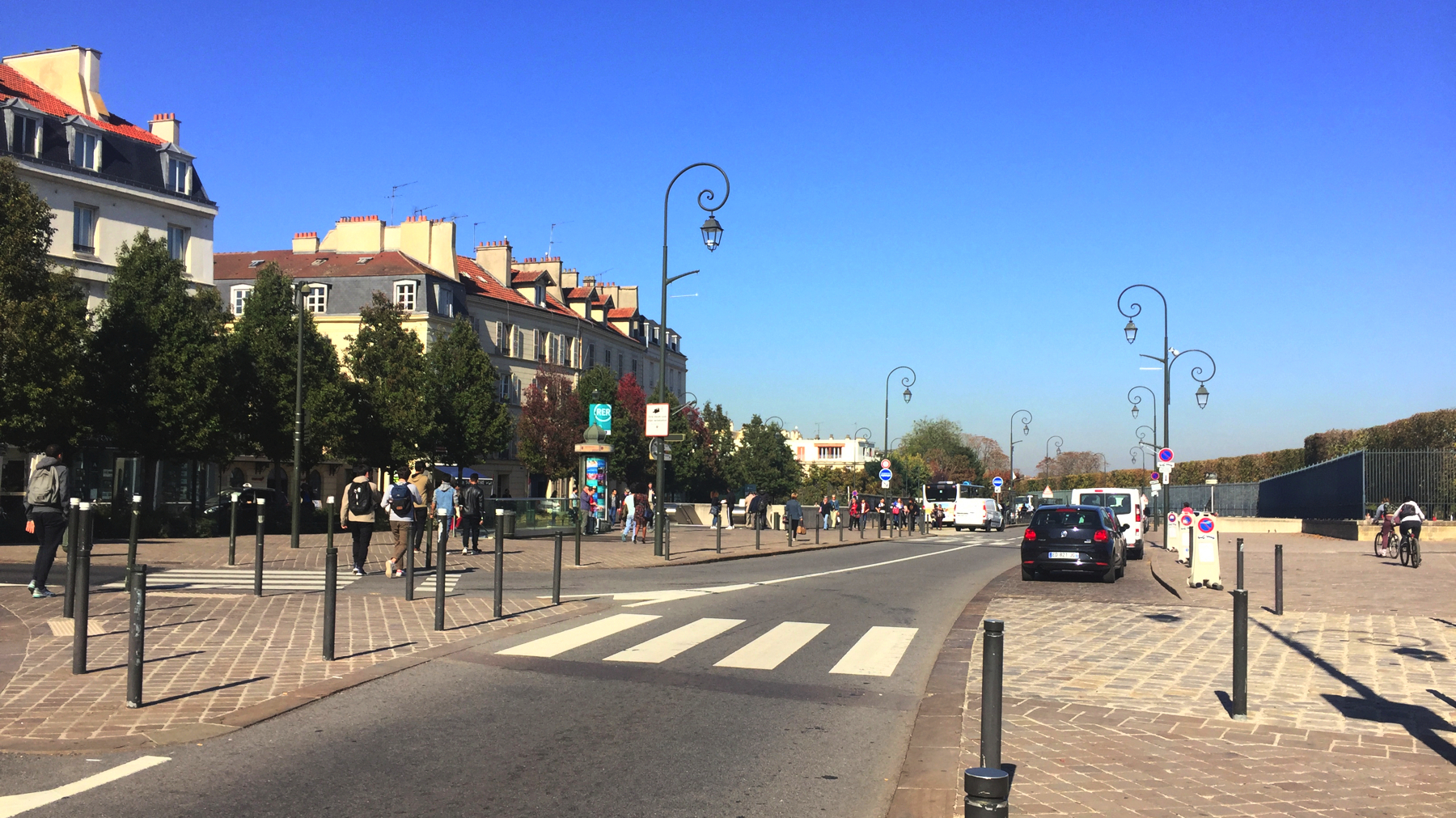
ATMOSPHERIC OPERATION
The Saint-Germain atmospheric system used a telegraph to alert the engine house and the two end points about train movements. The Dalkey railway did not, at least at first, relying instead on the timetable. The more complicated Croydon railway, with several engine houses, also used a telegraph, but incredibly the South Devon did not. I don't know whether Morse was used since only a few simple signals needed to be sent. The engine house needed six minutes' notice to start the pumps to create enough vacuum for the train to proceed. Given that time, Vésinet may have sent the signal based on hearing a locomotive whistle from Chatou.
Atmospheric power was used only for the climb up to Saint-Germain, The piston was put in the tube for the return trip by gravity, in the belief that air resistance would help control the speed. In the financial report by Louis-Alphonse Baude, June 1847, is the comment, On peut remarquer ici que lors de la descente du train, le châssis avec la tige restait dans le tube, glissant sans trop de friction mais ouvrant néanmoins la soupape longitudinale lors de son passage. — having the piston in the tube on the descent does not add much friction, but it does open the valve. It was not explicit but the point was that wear on the leather valve could be cut in half if the piston was lifted out when it was not needed, as was done on the Dalkey railway. This was ignored at the time.
The same report documents the cost of atmospheric operation. Baude excluded the bridges, tunnels, viaduct, station, and Flachat's two locomotives. The idea must have been that those would be needed for any kind of railway. The total specifically for atmospheric was 1,400,000 F, of which about 49% was for the engines and boilers and their buildings, and 35% for the pipe and valves. The remaining smaller amount included the piston carriages (wagons directeurs) and then some items that Paul Smith describes:
... divers dispositifs pour la manœuvre des trains : des chariots hydrauliques, utilisés en gare de Saint-Germain pour faire passer les wagons d'une voie sur l'autre lors de la composition des trains ; un cabestan, également à Saint-Germain, pour détacher le piston de son châssis et le poser en travers du wagon directeur pour le voyage de retour ; un autre cabestan, mû par une petite machine à deux cylindres oscillants, marchant à l'air raréfié et servant à treuiller le convoi par câble le long du palier horizontal jusqu'au sommet de la pante ; une grue tournante, enfin, utilisée au Vésinet pour ressaisir le piston et le remettre en place sur son châssis à l'entrée du tube.I give that in the original in case I missed some meaning.
The Saint-Germain terminus experienced the usual problems of shunting a train that had no power on board. The "hydraulic chariots" that moved cars must have been an interesting piece of technology. A capstan is a powered rotating cylinder to which a rope can be attached. The capstan and rope at Saint-Germain had to winch the outbound train about 200 meters to the top of the grade where the atmospheric pipe started. The capstan was powered by vacuum from the engine house. An early description also mentions a winch at Vésinet but not how it was powered. The South Devon also used a capstan at some locations.
The detail about the piston suggests that it was rotated, or taken off and reinstalled at the other end, as was done on the Croydon railway. Anyway the head had to be first going down hill, even though the train moved solely by gravity. The reason was that to lift and close the valve flaps it needed the action of the rollers. At least the Saint-Germain installation did not implement the questionable heaters that the Croydon used.
Below is an extremely detailed plan of the first type of wagon directeur used on the Saint-Germain line. The cross section, upper right, does not clearly show the Samuda linear valve, but with quite a bit of enlargement you may be able to see that the hinge is on the right hand side. I think the piston arm is mounted at the center axle as it was on the Croydon's six-wheel piston carriages. The car body is very narrow.
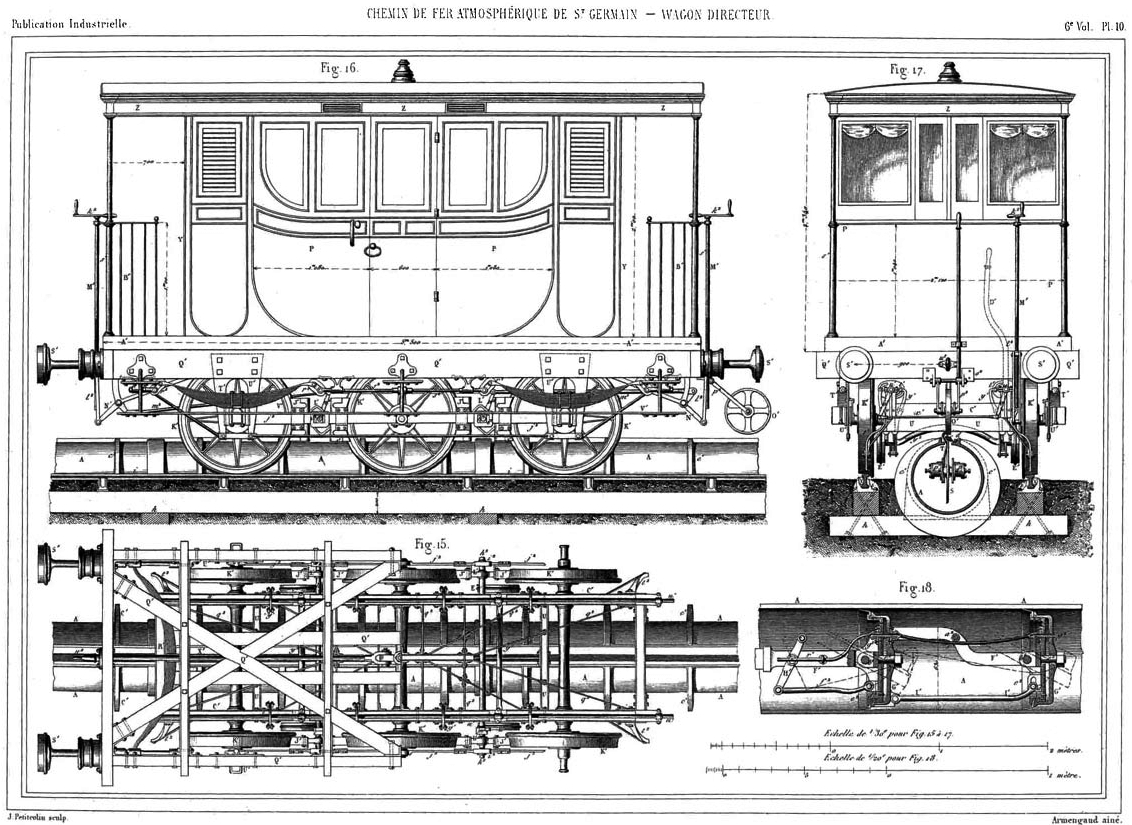
— "Chemin de fer atmosphérique de Saint-Germain, wagon directeur", from Armengaud Aîné, "Chemins de fer atmosphériques", in Publication industrielle des machines, outils et appareils les plus perfectionnés et les plus récents employés dans les différentes branches de l'industrie Française et Étrangère, 1848, via Paul Smith.
After the disastrous civil war year of 1848, the company began to make improvements. The valve lubrication that Samuda advised was a layer of rubber, vegetable wax, seal or horse oil, clay, and tar oil, and then a second layer of the same but without clay. This had to be touched up after each train by men stationed along the line, and the mixture needed to be modified in hot or cold weather. The company developed a better mixture of bone marrow, talc, horse oil, and creosote, that cut the expense in half.
Most significantly, in 1849 the piston carriage was eliminated as a separate vehicle. Its function was built into baggage cars, and the driver had a control to lift the piston. This not only saved wear on the valve when descending, but avoided any need to rotate the piston. It also shortened handling time at Vésinet since the baggage-piston car went through to Saint-Lazare. An eastbound train stopped there only long enough for a waiting locomotive to back onto it. Shunting at Saint-Lazare moved the baggage-piston car so that it would be behind the locomotive when the train departed Paris. At Vésinet the locomotive detached and crossed to an adjacent track, where it pulled the train forward by rope until it entered the pipe. Brilliant.
The illustration below is the combined baggage-piston car that was "abandoned in 1859" (actually 1860).
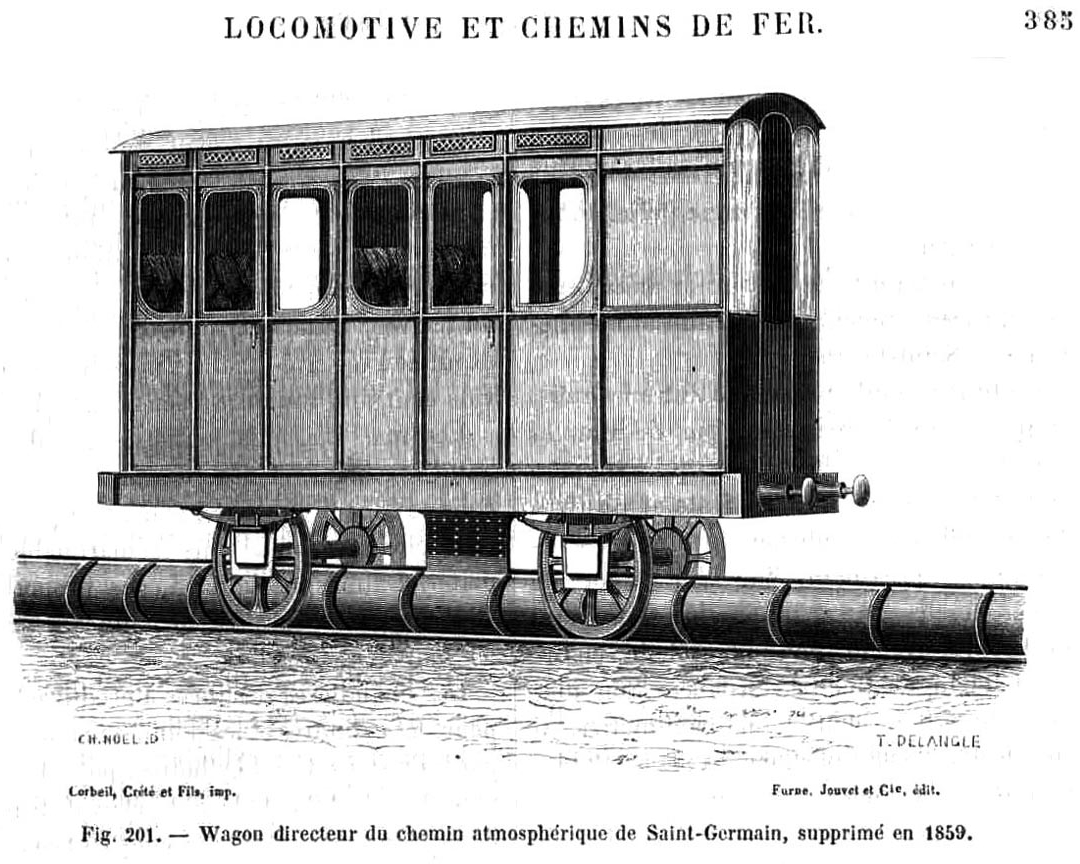
— "Wagon directeur du chemin atmosphérique de Saint-Germain", from Louis Figuier, Les marveilles de la science ou description populaire des inventions modernes, 1867, via Paul Smith.
In a smaller but significant change, the pipe was extended closer to Saint-Germain station. By a design flaw the end had been right at the top of the grade, which meant that the train was still going up the incline when it lost power. To compensate the engine had to pump hard to give the train enough speed to coast over the summit and reach the station. Extending the tube reduced fuel costs, and probably also reduced anxiety in the engine house. The top of the grade was not at the engine house, which I think is clear from postcard views above, but (based on a hearing to be quoted below) in the tunnel just outside the station.
THE COLLISION OF 1858
The descent was the most dangerous part of the railway since the only control was hand brakes. One of the tests carried out in 1847 sent a wagon loaded with two tonnes of cast iron down the slope from Saint-Germain. There was no driver or brake. Data was collected from observers with watches with second hands. The speed reached 43 kph by the time the wagon left the tunnel, held back by air resistance, and increased in the open on the viaduct up to 65 kph. It slowed to a stop sur la partie du chemin de niveau, but how far along the level part was not stated. The worst case seemed to be that a train would run through Vésinet and stop farther on.
On Monday, 6 September 1858, ten passenger cars behind a baggage-piston car left Saint-Germain as the 22:00 eastbound, running at least ten minutes late because of a delayed arriving train. The brakes failed. The train did not derail but rolled at an increasingly excessive speed. At Vésinet it collided with the locomotive and tender that would have taken it to Paris. The baggage-piston car was broken to pieces, killing the driver, and the second car climbed onto it, killing two passengers. About forty other passengers were treated for injuries, out of a total estimated at three hundred. The reputation of the atmospheric system was badly damaged. The collision is considered a reason that the Ouest railway discontinued atmospheric operation in July 1860, although another and probably more important reason was a company program to replace old track and equipment systemwide.
It was not the only problem on the atmospheric by that date, but certainly the worst. The linear valve was wearing out. The company had to keep locomotives in steam at Vésinet to rescue trains stuck by poor vacuum. The greatest danger from a safety standpoint was that passengers sometimes ignored orders and got off a train that was stuck and walked along the other track, an especially dangerous practice in the tunnel, where the driver of a rescue locomotive would not have a good view of their presence. By chance no such accident took place. Renewing the linear valve was a major investment that was unlikely to have been made regardless of the collision of 1858.
In October hearings were convened by the Imperial Prosecutor. The transcript is available here so I will pick out only some items about operations.
The lower end of the atmospheric is referred to as Vésinet and as a gare, although as I have mentioned, it is not shown as a station on maps or listed as such in guidebooks. The distance between the stations is given as 2,432 meters (1.5 miles) and the difference in elevation as 51 meters (167 feet). The last 730 meters is said to be level. Based on this the average grade is 51/1702 or 3%. Vésinet is described as being between two overbridges called Montesson (Route de Montesson) and Chatou (now Boulevard Carnot), and as being closer to the former. There were four tracks, described as follows. The track numbers are my own.
Seen from the station, left to right, looking toward Paris:Following English practice the "up" track is not the one going literally up the incline but the one going toward the major city! It's interesting that the tracks on the incline are referred to as up and down tracks since both were bi-directional. Track 1 was called fosse (ditch), as in the term pit stop used in car racing.
1, pit track, with a turntable, 275 meters long
2, up main track to Paris
3, down main track
4, siding
Seen from Montesson bridge, left to right, looking toward St-Germain:
4, "engagement" track from which trains on 3 are pulled to the pipe
3, down main track, with atmospheric pipe to St-Germain
2, up main track, with no atmospheric pipe
1, siding
Also: 0, a diagonal track stepping from 1 to 4
The routine at Vésinet seems simple at first. Westbound, the train comes in on 3, and the engine uncouples, crosses to 4, and pulls the train by rope up to the pipe. Eastbound, the engine waits on 2, and backs onto the arriving atmospheric train. It's more complicated than that, because the engine and its tender each have to move in and out of track 1 to be rotated, and in doing so they cross and for a short time occupy the main tracks.
The normal procedure for an eastbound train leaving Saint-Germain follows. The station master at Saint-Germain sends a telegraph signal to Vésinet about the imminent departure and gets back a reply that the track is clear (normally the letters "CO"). Given this response Saint-Germain sends the train off. It is pulled by rope up to the capstan located at the top of the grade, where the rope is released and the train runs free. The brakes are partially applied to control speed while running down the grade. When the train leaves the tunnel and comes onto the viaduct, the driver blows the horn to signal the train's approach. The normal speed was 30 kph (19 mph).
The collision involved two things that went wrong. First and most importantly, the three sets of brakes on the train did not prevent excessive speed. Whether it was from mechanical failure or human error was disputed. The railway superintendent maintained that the men had simply not applied the brakes energetically enough. The driver, who had the first brake, was dead, but someone testified that he was not always attentive to his duties. The man on the second brake (eighth car) was a station porter who had never performed the task before, and because the brake was damaged in the collision it was hard to say how well he had done. He said at the hearing that a passenger helped him turn the brake wheel as tight as they could. Only the third brake (tenth car) was handled by a trustworthy experienced man, who said that he had turned the brake wheel so hard that he saw sparks and smoke from below, and that he had sounded a horn to alert the other two brakemen about the speed. It was not enough.
The second problem was that the track at Vésinet was not clear. Remember the 22:00 train was sent out late from Saint-Germain because of a late arriving train. The running time between stations was only about five minutes, and the maneuvers of the locomotive and tender at Vésinet took about ten minutes. The station master there, who supervised the equipment moves, had been on duty for thirty-six hours. The testimony of various witnesses contested whether Saint-Germain sent the telegraph signal, and whether Vésinet replied, and even whether Saint-Germain needed to wait for reply. When Saint-Germain sent the signal the station master at Vésinet may have been outside the building seeing to the staff moving the locomotive and tender.
The result of a runaway would have been a collision regardless, but a question to a company official reveals an important detail. He was asked what would have been different if the buffers of the baggage-piston car had collided with the buffers of the tender, au lieu de prendre obliquement le tender de la machine. The implication is that normally the arriving atmospheric train would come to a stop on the same track as the engine and tender. But we learn from the question that the train hit the tender obliquely, which means that one of the two was crossing to another track at the time of impact. The engine and tender were not yet in their proper position. It made little difference, since the the answer was that although the baggage-piston car might not have overturned it still would have splintered on impact.
The testimony is hard to follow because (besides being in French) questions were asked and answered that were more about general matters than the collision case at hand. The train had a fourth brake car with a broken brake, but it was said to be in the consist simply to accommodate passengers, because for that length of train only three brake cars were required and three were present. And yet, a fourth brake man was assigned to the broken car: a company rule perhaps. Even stranger was a lengthy discussion about whether the signal at Vésinet had been set to danger while the maneuvers were done. As if it would have stopped a runaway!
Predictably, the management of the company was held blameless. Nothing about brake inspections, staff training, excessive hours of work, none of that suggested any liability under the law. The prosecutor did mention that there could be civil liability. I don't know whether that was pursued. Four employees were given sentences ranging from two to six months. Berger, the experienced brakeman who did as much as he could to set his brakes and warn the others to set theirs, got the two month sentence for his trouble. sic semper.
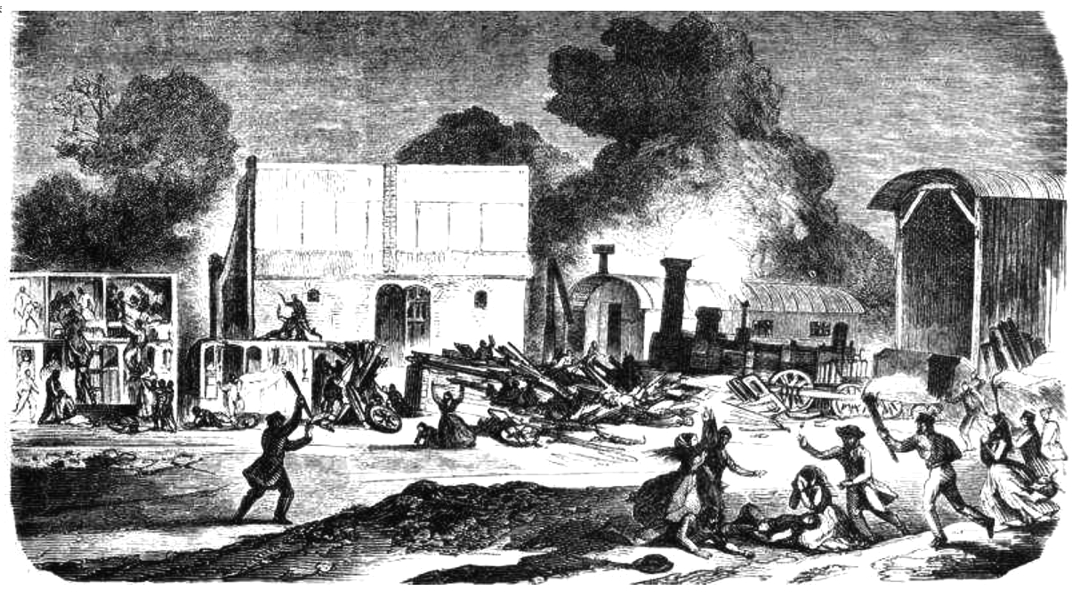
— "L'accident ferroviaire du Vésinet du 6 septembre 1858", via le site de la Société d'histoire du Vésinet.
The illustration above is supposed to show the scene, but it looks like a head-on collision with a locomotive, not the side swipe of the tender in the testimony. I put it here for what it is worth. It might be the only image of the buildings at Vésinet.
CHEMINS DE FER L'OUEST
Atmospheric operation ended on 2 July 1860. The Saint-Germain was the last of its kind, outliving Croydon, South Devon, and Dalkey. As I mentioned on the Le Pecq page, services were diverted to the old Le Pecq riverside terminus for a while. When trains ran again to Saint-Germain they made two new stops, Vésinet (now the Vésinet-Centre station) and Le Pecq, (now Vésinet-Le Pecq).
Atmospheric power was replaced by four engines similar to 0-6-2 Antée, still with a power change at what was now called Le Pecq. The atmospheric pipe was sold for scrap iron. The huge engines at Saint-Germain were sold to a company that used them the next year as blowing machines for the first French test of a Bessemer converter, to make steel.
Eventually more powerful locomotives ran through from Saint-Lazare, and they in turn were replaced in 1927 by third-rail electric trains. A more radical change took effect in October 1972 when RER line A took over the service. Line A comes in from central Paris as an underground railway that surfaces at Nanterre-Université alongside the railway from St-Lazare to points west. From there to Saint-Germain all of the stations were completely rebuilt and overhead electric catenary replaced the third rail.
The map below shows the extent of the Chemins de fer de l'Ouest near Paris when it was consolidated in 1855. Nothing more had been added by 1860. I also put in the locations of the other Paris termini for reference. The dates are those of the earliest terminus at the location, which in some cases had a different name at first, particularly Paris-Montparnasse which was for a time simply Gare l'Ouest. Stations shown are complete based on information from maps up to 1867.
The Chemin de fer de Paris à Saint-Germain itself constructed the short branch to Argenteuil and the innovative branch within the city of Paris to Auteuil. The latter was built in open cut with closely spaced stations, for passenger traffic only, making it arguably the first urban rapid transit railway in the world. Use declined after the Paris Metro opened, but the middle section of it was revived in 1985 to be part of RER line C.
